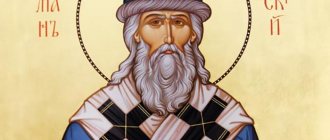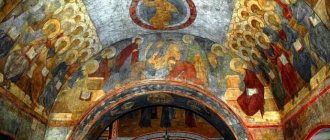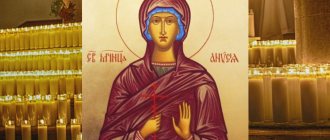AGNIYA
[Agnessa, Anna; lat. Agnes from Greek. ῾Αγνή - immaculate] († III century or early IV century), mts. Rimskaya (memorial, January 21, July 5; memorial, January 21 or 28). The life of this saint is known in 3 editions, compiled in the end. IV - beginning V century based on written acts and oral traditions of St. Ambrose of Milan, Pope Damasus and Prudentius. The martyrdom acts of A. that have come down to us are considered inauthentic. Sources are unanimous only that at the time of martyrdom A. was 12 years old.
A. gen. in Rome in a rich and noble family. Already at the age of 12 she received an offer to marry Rome’s son. praetor Symphronius, captivated by her beauty, but A., who decided to devote herself to God, refused him. St. Ambrose reports that for this she was beheaded with a sword. According to another version, A., by court verdict, was stripped and put out on the street, but her thick, long hair flowing covered her nakedness. A. was taken to a brothel. There, during an attempt on her purity, a miracle occurred: an angel appeared and dressed A. in white clothes, from which the room where the saint was was filled with a dazzling radiance, and everyone who came to the brothel knelt before the holy virgin and left , glorifying God. Among them was the son of Symphronius, who had previously sought her hand; he was not stopped by the wonderful radiance, and as soon as he tried to touch A., he immediately fell dead. At the request of his father, A. resurrected the young man, turning to God in prayer. The resurrected young man and 160 people, witnesses of this miracle, glorified God, became Christians and subsequently. were beheaded with a sword. The martyr was doomed to be burned, but she emerged from the fire unharmed. According to Pope Damasus, A. nevertheless accepted martyrdom at the stake; Prudentius writes that she was beheaded. It is impossible to accurately determine the time of her death: it happened either in mid. III century, during the persecution of the emperor. Decius or Valerian (251 or 258-259), or in the beginning. IV century, during the persecution of Diocletian (303-304). A.'s parents buried him not far from their home. villas on the Nomentan road. The Christians gathered at her grave were attacked by the pagans and stoned their peer A. St. who dared to denounce them. Emerentianu, the memory of the cut is celebrated on the same day; immediately many of the murderers fell dead, struck by lightning. After several days after this, a miraculous appearance of A. occurred to his parents in a host of virgins with an immaculate lamb, a symbol of Christ, in their arms. Therefore, the symbol of A. is a lamb. It is possible that the very name of the martyr is the name given to her at Baptism, and her original name is unknown. blzh. Augustine notes that A.’s very name indicates her virtue.
The veneration of A. was established in Rome already by the 4th century. and soon spread throughout the West. Churches. Her memory is January 21. present in the most ancient calendars - the Roman Bucherian (354) and Carthaginian (V or VI centuries); Jerome's martyrologist also indicates the celebration of the “eighth day” (A.’s appearance to his parents on the 8th day after death). At the same time, there is no exact news about the time of A.’s martyrdom, and its circumstances are described differently in the earliest sources. There is also a memory of a certain MC. Anna (July 5), Krai is identified with A.
The tomb of A. on the Nomentan road forms the center of the Christian complex. burials of the famous catacomb named after her; Part of the tombstone with the inscription: “AGNE-SANC-/TISSIMA” has been preserved.
According to Nicephorus Callistus Xanthopoulus, A.’s relics were kept in the K-field in the c. St. Lawrence in the Pulcherians. During the time of the imp. A c. was erected over the grave of Constantine the Great. St. A., where there is a mosaic image of the saint dating back to the 6th century; According to legend, the church was built on A.'s grave in honor of the healing of Constantine's daughter Constantia. There is also an older (IV century) sculptural image of A. in marble. Under Pope Honorius I († 638) this church was rebuilt. In Rome there is another church, consecrated in the name of A., built on the supposed site of the prison in which the martyr was imprisoned. In this church, every year on the day of memory of A., the pope blesses the lambs, from whose wool a pallium (omophorion) is made, which the pope gives to the newly appointed archbishops. Part of A.'s relics was transported to Utrecht (Netherlands), where their first discovery, ca. 964, celebrated on March 3 (second transfer - 1421). In Paris, the transfer of A.'s relics to the church of St. Eustache is celebrated on the 4th Sunday after Easter. A. is the patroness of young girls, as well as gardeners; her life, which was included in the popular Middle Ages. Sat. "Golden Legend", known throughout Europe. languages and in spiritual verses. On the eve of A.'s memorial day, people practice fortune-telling; in particular, in England, girls on this day try to find out about their future. spouses.
Source: BHL, N 156-167; BHG, N 45-46; Ambrosius. De virg. I 2, 7; De offic. I 16, 203; Damasi Epigr. 43f n. 43; Prudentius. Peristephanon 14 // PL. 60. Col. 580-590; ActaSS. Jan. T. 2. P. 350-363; Ruinart. Acta. T. 2. 1803. P. 32-91; JSV. January. pp. 245-254.
Lit.: Franchi de'Cavalieri PS Agnese nella tradizione e nella leggenda. R., 1899; Dufourcq A. Étude sur les gesta martyrum romains. P., 19002. T. 1. P. 23, 26, 28-29, 214-217; P., 19072. T. 2. P. 53-60; PBE. T. 1. Stb. 280-286; Allard P. Agnes (Saint) // DACL. T. 1. Col. 905-918; Leclercq H. Agnès (Cimietière de Sainte-Agnès) // Ibid. Col. 918-965; Yubaru FS Agnes. P., 1907; Sergius (Spassky). Monthsword. T. 3. P. 33; Krautheimer R. Corpus Basilicarum Christianarum. R., 1937. T. 1. P. 14-39; Deichmann FW Frühchristliche Kirchen in Rom. Basel, 1948; Janin. Eglises et monastèries. P. 9.
A. I. Makarov
Iconography
Mts. Agnia. Mosaic c. Sant'Agnese fuori le Mura in Rome. 625-638
Mts. Agnia. Mosaic c. Sant'Agnese fuori le Mura in Rome. 625-638
Images of A., one of the earliest in the iconography of holy martyrs, are already available on the bottoms of glass bowls of the 4th-5th centuries. (Vatican Museums, Bologna), found mainly in Rome (some from the catacombs of Sant'Agnese): A. is presented in the pose of an oranta, in the rich clothes of a patrician, with her hair tied up (sometimes with her head covered), and with earrings in the ears. In the Middle Ages. In art, A. was depicted, as a rule, with her head covered or wearing a precious crown, which is a symbol of the reward for martyrdom and indicating the noble origin of the saint. The attributes of A. are: a lamb (for the first time on the mosaic of the northern wall of the central nave in the Basilica of San Apollinare Nuovo in Ravenna, 556 or 569; on the flavellum from Tournus, early 9th century (Bargello Museum, Florence); in The Synaxis of Saints in the Maesta by Duccio di Buoninsegni, 1311 (Cathedral in Siena); among the holy women in the Van Eyck brothers, 1st quarter of the 15th century (Cathedral of St. Bavo in Ghent)); palm branch (late 13th century stained glass window, Church of St. Dionysius in Esslingen); lily and vine (lost fresco in the oratory of San Silvestro in the church of San Martino ai Monti in Rome, 13th century); a sword or dagger is an instrument of martyrdom. Numerous images of A. have been preserved in Rome. churches: mosaic in the apse of Sant'Agnese fuori le mura, 625-638, - with the upcoming ones, in growth; fresco in c. Santa Maria Antiqua, 817-824; fresco in the Oratory of San Silvestro, c. 844 - with a pearl crown in hands, together with other holy wives, the Mother of God stands; mosaic in the Basilica of Santa Prassede, early IX century; fresco in Santa Maria Antiqua, 10th century, - bust image in a medallion; mosaic in the chapel of St. Lawrence in the Lateran, 1215-1227. Cycles of images with scenes of A.’s life, miracles and torment were preserved in the c. Santa Maria di Donna Regina in Naples, ser. XIV century; in c. San Teodoro in Pavia, early XVI century, and were also widespread in Western art. Europe XV-XIX centuries. (paintings by G. David, Tintoretto, H. Ribera, Domenichino, Murillo).
Iconography: Detzel. Bd. 2. S. 46, 47; Kondakov. Iconography of the Mother of God. T. 1. P. 75-82, 86, 282, 335, 342-343; Kunstle. Bd. 2. S. 39-43; Doyé F.v. S. Heilige und Selige der römisch-katholischen Kirche, deren Erkennungszeichen, Patronate und lebensgeschichtliche Bemerkungen. Lpz., 1929. Bd. 1. S. 30; Ricci. P. 13, 14; Braun. Tracht und Attribute. S. 45-49; Roig JF Iconografia de los Santos. Barcelona, 1950. P. 136-137; Kaftal G. Iconography of the Saints in Tuscan Painting // Saints of Italian Art. Firenze, 1952. N 5, 9-13; idem. Iconography of the Saints in Central and South Italian Schools of Painting // Ibid. 1965. N 8-10; Reau. Vol. 3/1. P. 33-39; Frutaz AP Il complesso monumentale di Sant'Agnese e di Santa Costanca. Città del Vaticano, 1960; Sciubba S., Sabanti L. Sant'Agnese in Agone. R., 1962; Zimmermanns K. // LCI. Bd. 5. Sp. 58-63.
V. E. Suslenkov
Astrology and name talismans
Agnia – astrological attributes of the name:
- Among the celestial bodies, the girl is protected by the Sun.
- The zodiac sign in harmony with Agnia’s character is Aquarius.
- The element related to the bearer of the name is Fire.
- Color – purple, developing mystical abilities and philosophical vision.
- A companion from the animal world is the salamander.
- The tree that harmonizes the life of the ward is cypress.
- The patronizing plant of the bearer of the name is calendula.
- The talisman stone is a fire fighter.
- The metal that reflects the state of the soul is nickel.
Meaning of a girl's name
Agnia is smiling, friendly, willingly agrees with any judgments - and firmly follows her own path. Young Agnia relies only on her own strength and does not trust anyone, not even close relatives. The girl's main concern is to get a good education. Agnia will enter a prestigious university two, three, four times - but she will achieve her goal.
These are strict women, restrained and strong-willed. They tend to be very careful when making decisions. Agnia is very feminine, but has a very refined taste and, as a rule, dresses elegantly. Agnia has the gift of eloquence and strives for perfection in everything.
The world as it appears does not satisfy Agnia. And in her attempts to “improve” him, Asya often suffers disappointment. Agnia has great restraint and is principled. A good education is of particular importance to Agnia and, having good taste, she can become an expert in various fields of art - music, painting, ballet. Asya's life path is determined unmistakably. Their inner world is unusually rich and, if you earn trust, communicating with her will give you great pleasure.
The girl Agnia is very affectionate and has a hard time dealing with a breakup. This is a faithful and sincere friend and a loving, sensual wife. We should not forget about her deep emotionality, since Agnia is very vulnerable.
The meaning of the zodiac sign and time of year of birth
This name takes on new qualities when combined with zodiac signs:
- With Aries - hot temper, assertiveness, ability to get one's way.
- With Taurus – stubbornness, impulsiveness, inconstancy.
- With Gemini - artistry, dreaminess, creativity.
- With Cancer – emotionality, sensitivity, vulnerability.
- With Leo - charisma, narcissism, thirst for the attention of others.
- With Virgo - diligence, scrupulousness, delicate taste.
- With Libra - a sense of tact, sociability, the ability to find an approach to a person.
- With Scorpio - independence, strong character, ability to provide for oneself.
- With Sagittarius – swiftness, the ability to reveal the feelings of the interlocutor.
- With Capricorn - the ability to set realistic goals and not deviate from the intended route.
- With Aquarius - tirelessness, developed imagination, creative abilities.
- With Pisces - the depth of the inner world, demanding of others.
In addition to the signs of the zodiac, Agnia is influenced by the time of year in which she was born.
| Season | Character |
| Winter | Contradictory nature, emotionality |
| Spring | This time of year teaches elegance, a subtle sense of style, and the desire to fill the space around you with beauty. |
| Summer | Summer instills showiness, eccentricity, and the ability to charm men with one glance |
| Autumn | Autumn brings balance, ability to gain attention, leadership qualities |











